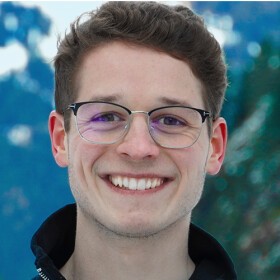‘We have created a functioning business model’ - Interview with Floy founder Benedikt Schneider
The start-up Floy develops AI-supported software solutions that can be used to detect abnormalities in MRI and CT images, including bone tumours or brain aneurysms - if the patient requests it. We spoke to founder Benedikt Schneider about the business model, among other things.
Mr Schneider, you founded Floy after you had a personal experience with a doctor. What exactly prompted you to focus intensively on the use of AI in radiology?
Benedikt Schneider: My experience with a delayed diagnosis was the trigger for me to look into the challenges of radiology. I had a meniscus tear that was recognised too late and asked my radiologist at the time why he wasn't using AI. That was in 2019, and I quickly realised that radiologists work with huge amounts of data, but many opportunities remain untapped. I started to delve deeper into the topic and developed an initial prototype together with a fellow student.
Your product has been approved and is already in use in 250 medical practices. Why are you further ahead here than some other AI providers in radiology?
Benedikt Schneider: Radiology AI companies were founded years ago, especially in America, but also in Israel and Asia, when I was still at primary school. But none of them really managed to establish their offering on the market, and that was mainly due to monetisation. Many companies were counting on health insurance companies to reimburse AI-supported diagnoses at some point - but that didn't happen. They also tried to sell radiologists an increase in efficiency that was hardly economically viable. We have reversed the approach: our AI offers patients an additional service that they pay for themselves - and the radiologist receives a monetary benefit as a result. We have thus created a business model that works independently of political and regulatory developments.
What hurdles did you have to overcome to integrate AI technology into a traditionally conservative field such as radiology?
Benedikt Schneider: The biggest sticking point was that some radiologists considered AI to be science fiction just a few years ago. We first had to demonstrate the technical advantages and then make it clear that our model was economically viable. At the same time, we worked closely with radiologists early on to ensure that our solutions could be seamlessly integrated into everyday practice. Today, we can see that the acceptance of AI in radiology has increased significantly.
A decisive factor for the success of AI in diagnostics is the database on which it is trained. How does Floy ensure that its AI models are based on high-quality and representative data?
Benedikt Schneider: Our models are trained using data from radiology practices that precisely represent the patient populations that our AI will later support in practice. We work closely with our partners to ensure that the training data is representative and medically valid. We also cooperate with research institutions such as the German Cancer Research Centre (DKFZ) to further improve the quality of our AI. Each data set is carefully checked and annotated by radiologists to ensure maximum accuracy.

The use of AI is changing the work of radiologists. © Envato
The market for AI in radiology is growing, but there are still challenges - from regulatory hurdles to acceptance. Where do you currently see the biggest obstacles to the widespread use of AI in imaging?
Benedikt Schneider: One major obstacle is the certification of AI products, as the regulatory requirements are very high. We took this seriously from the outset and involved experts at an early stage in order to organise the process efficiently. Many companies fail because they only think about authorisation after product development - the documentation has to be included right from the start. Reimbursement by health insurance funds also remains a hurdle, which is why we have deliberately chosen a different path.
How do you think the role of radiologists will change over the next ten years? Will AI only complement diagnostics - or do you even see a partial automation of certain processes in the long term?
Benedikt Schneider: In the next ten years, AI will support radiologists in their work, but not replace them. Radiology is a complex field that is not just about recognising patterns, but also about making clinical decisions. AI can help to highlight certain abnormalities and provide structured additional information, but the final judgement will still lie with humans. In the long term, the profession of radiologists could evolve towards a role in which they increasingly interpret AI-supported results and place them in a clinical context.
Floy currently uses pixel-based AI, but there are approaches to developing multimodal systems that combine image analyses with other data sources. Which technological trends do you think are particularly promising?
Benedikt Schneider: One promising trend is vision-language models that combine image data with text interpretation. In future, such models could generate entire findings by linking the image with patient data and other information. We are already working on such concepts with partners such as the DKFZ, but this is currently still an exploratory field. In the coming years, the further development of our AI models will focus on expanding the recognisable indications.
Thank you very much for the interview.
About the person
Benedikt Schneider developed the idea for Floy while studying International Business Administration at the Otto Beisheim School of Management (WHU) and founded the company after completing his bachelor's degree in 2021. The certified software solutions FloyBrain, FloySpine and FloyMammo support radiologists in the detection of complex and difficult-to-identify diseases. Floy counts investors such as HV Capital and Accurio Ventures among its supporters.


